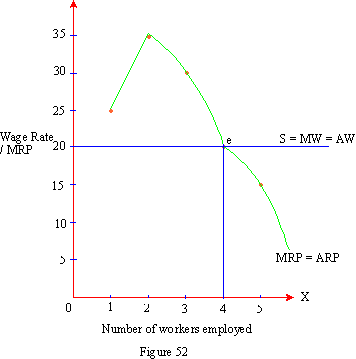|
14.2 Marginal Productivity Theory
(A) MPP and MRP: Just as demand and supply forces together determine prices and quantities of goods exchanged in the product market similar rules operate in the factor market. If the labor market is assumed to be competitive then the rate of wages will be fixed and uniform. At such a competitive wage rate a firm has to decide how many workers it can profitably employ. In other words, a firm has to determine its own demand for labor. The productive contribution of an additional or marginal worker governs such a demand for labor since labor is a productive service. A firm is guided in this respect by the marginal productivity rule. The most important principle determining demand for labor is called Marginal Productivity Theory. It attempts to relate marginal contribution to the output produced and the rate of wages required to be paid to the marginal worker. Wages are paid in cash or money units while the product is measured in physical units. To make the comparison convenient Marginal Physical Product (MPP) is converted into Marginal Revenue Product (MRP). For this purpose, MRP is multiplied by the marginal revenue earned by a firm in the curve. If a firm is operating under a competitive product market then the price or the average revenue and marginal revenue values are identical. MRP is Price ´ MPP under competition. This same value is MR ´ MPP under imperfect markets.
MRP = MPP ´ Price ® Competition
MRP = MPP ´ MR ® Monopoly, Oligopoly etc.
(B) A Firm’s Demand Curve: Let us begin with the simple case of a competitive market. There is competition both in the labor market and the product market. Price of the product is assumed to be $5. The firm has to determine its demand under the following productivity conditions:
| No. of
workers Employed |
Total
Physical Product |
Marginal
Physical Product |
Marginal
Revenue Product
(MPP $5)
|
| 1 |
5 |
5 |
25 |
| 2 |
12 |
7 |
35 |
| 3 |
18 |
6 |
30 |
| 4 |
22 |
4 |
20 |
| 5 |
25 |
3 |
15 |
In the example, the number of workers employed increases progressively from 1 to 5. With more workers employed total output continuously increases from 5 to 12…to 25 units. Marginal product initially rises from 5 to 7 (12-5=7) but subsequently falls from 7 to 6, 4, and then 3. Under competitive product market MRP or money value of the MPP at a fixed price of $5 will be 25, 35, 30, 20 and 15. The firm will decide how many workers need to be employed depending on the present market rate of wages. If the rate of wages is as high as $35 per worker, the firm can employ only two workers. With the wage rate as low as $15 the firm can employ five workers. If we assume that the actual competitive labor market wage rate is $20 the firm can employ 4 workers and remain in equilibrium. At this wage rate the demand and supply forces have been equated.

In Figure 52, we have MRP, the demand curve for labor. This is the downward sloping curve showing a progressive fall in the productivity of labor. It enables the firm to employ more workers only at a lower wage rate. The labor market is competitive and $20 is the fixed uniform rate of wages. At this wage rate any number of workers will offer services. Therefore the labor supply curve is perfectly flexible. It is represented by the horizontal straight line WS (AW = MW) curve. The rate of wages as a price of labor is equal to both the average wage and the marginal wage per worker. The demand and supply curves intersect at the point of equilibrium e. At this point a firm employs N = 4 workers and pays W = $20 as wages. This is a profitable situation for the firm.
[next page]
|